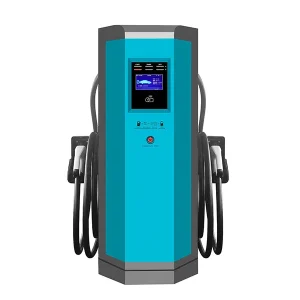-
By Charging Speed
-
-
Features: High power (commonly 30 kW, 60 kW, 120 kW or more), capable of replenishing large amounts of range in a short time.
-
Typical Locations: Highway rest areas and public fast‐charge stations in cities—ideal for long‐distance travel and emergency top‑ups.
-
-
AC Level 1/Level 2 (Slow) Chargers
-
Features: Lower power (usually 3.3 kW or 7 kW), slower charging but lower cost and easier installation.
-
Typical Locations: Home garages, apartments/condo parking lots, workplace parking—perfect for overnight or all‑day charging.
-
-
-
By Installation Site
-
Public Charging Stations
-
Features: Installed in public parking lots, shopping centers, highway rest stops, etc., and open to all drivers.
-
Pros & Cons: Wide geographical coverage; but peak‐hour queues can form.
-
-
Private (Residential) Chargers
-
Features: Mounted on an individual’s own parking spot or garage and reserved for that owner’s use.
-
Pros & Cons: High convenience and privacy; installation may require property‑owner approval and a dedicated parking space.

-
-
-
By Technical Approach
-
High‑Voltage Fast‑Charge Technology
-
Features: Uses elevated voltages to reduce losses, cut weight/size, and boost charging speed—poised to be a mainstream solution.
-
Ideal For: Scenarios demanding rapid turnaround, such as highway corridors or dense urban centers.
-
-
Battery‑Swap (“Swap‑and‑Go”)
-
Features: Drivers exchange a depleted battery for a fully charged one in just a few minutes.
-
Current Status: Rollouts are limited to specific vehicle models and networks, though especially suited to fleet or taxi applications.
-
-
-
By Geographic Market
-
Tier‑1 & East‑Coast (Developed) Regions
-
Traits: High EV adoption and dense charging infrastructure.
-
Key Focus: Optimizing station placement, streamlining amenities, and enhancing user experience.
-
-
Central & Western (Emerging) Regions
-
Traits: Growing EV demand but presently lower charger coverage.
-
Key Focus: Policy incentives and partnerships to accelerate charger deployment.
-
-
-
By Power Rating
-
Low‑Power Chargers (< 60 kW)
-
Features: Lower technical barriers and cost; common in the early build‑out phase.
-
Use Case: Basic “top‑off” charging, e.g., overnight at home or at workplaces.
-
-
Mid‑ to High‑Power Chargers (60–480 kW)
-
Features: Much faster fill‑ups, suited to public fast‑charge stations.
-
Use Case: City fast‑charge hubs and highway rest stops.
-
-
Ultra‑Fast Chargers (> 480 kW)
-
Features: Provide massive power for ultra‑quick charging sessions.
-
Outlook: Still emerging, but expected to drive next‑gen fast‑charge networks.
-
-
-
By Business/Operation Model
-
State‑Owned Utility Model
-
Example: National grid operators install and manage chargers as part of their power‑distribution network.
-
Strengths: Deep grid‑management expertise and financing.
-
-
OEM Ecosystem Model
-
Example: Automakers or tech OEMs (e.g., Huawei, Xpeng) build proprietary “super‑charge” networks to lock in customers.
-
Strengths: Seamless user experience and integrated billing/loyalty.
-
-
Third‑Party Operator Model
-
Example: Independent networks (e.g., Teld) leverage scale to build widespread public charging.
-
Strengths: Agnostic access, often attractive pricing and partnerships.
-
-
-
By Cutting‑Edge Innovation
-
PV + Storage + Charging Integration
-
Features: Combines on‑site solar generation, battery storage, and EV chargers to supply green power and buffer grid demand.
-
Ideal For: Industrial parks, commercial campuses—reduces peak charges and enhances resilience.
-
-
Mobile Charging Robots
-
Features: Self‑propelled units that you summon via an app; they autonomously locate your vehicle, plug in, and recharge it.
-
Use Case: Urban areas with limited infrastructure or unexpected range emergencies—provides on‑demand, flexible charging.
-
-
2025年4月17日
420


